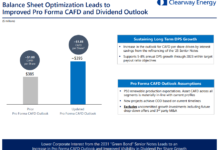Jennifer Runyon
According to Richard Kauffman, Senior Advisor to the Secretary, DOE, making REITs or MLPs available for renewable energy project financing is the key to advancing the industry.
Top engineering, procurement and construction firms gathered to network, learn and do business with corporate-level project developers at the PGI Financial Forum, one of four co-located events that took place in Orlando, Fla. earlier this month. Richard Kauffman, Senior Advisor to the Secretary of the U.S. Department of Energy, gave the keynote address during a luncheon that took place during the conference.
During the luncheon, Kauffman explained to the 100 attendees that as someone who originated from the private sector, in his DOE role he is trying to understand where market forces can be harnessed in order to unleash the flood of investment that is needed to bring about large renewable energy projects.
Kauffman explained what he sees as a disconnect between returns in renewable energy projects compared to returns in other investments. On the one hand, today, renewable energy projects are financed in what he called an “old-fashioned, archaic way” where for the most part, projects rely on private sector money that is looking for high rates of returns, typically around 12-14 percent. On the other hand, money managers, wary of the stock market and its risks, have returned to the bond markets, which offer more steady (but lower) rates of return, in the 5 or 6 percent range. Kauffman explained that this “wall of money” that is looking for a stable rate of return, such as what can be found in the bond markets, could easily invest in renewable energy projects if only the financial vehicle existed that allowed it to. Renewable energy projects with signed power purchase agreements (PPAs) will deliver a healthy rate of return to their investors, one that will be stable for 20 years, exactly what the money managers are looking for.
In other words, he said, there is all this money looking to invest in yield but it can’t flow to where it is needed because the financial vehicles don’t yet exist that would allow it to.
Enter Real Estate Investment Trusts (REITs) or Master Limited Partnerships (MLPs).
According to Kauffman, REITs and MLPs, function like a bond and are currently used in more mature markets for project development. If they were available to renewable energy projects, said Kauffman, they would unlock loads of money for project development. Two separate bills have already been introduced in Congress seeking to allow renewable energy projects to be financed through REITs and MLPs but neither bill has come up for vote yet.
Kauffman asked Financial Forum attendees to imagine for a minute what would happen if MLPs or REITs could be used to finance renewable energy projects. He asked attendees to imagine that they would have a yield of 5 or 6 percent and simply through that yield, the cost of capital would go down by 50 percent (since private sector funding demands returns in the 12 to 14 percent range.)
“But I think it would do five other things,” he explained.
First, Kauffman said that renewable energy REITs or MLPs would accelerate standardization in the contracting process. With so many projects now eligible for project finance, the markets would demand a streamlined contracting process. This would remove more of the soft costs from project development.
Second, these renewable energy financial vehicles would continue to force down solar and other supply chain costs. Kauffman explained that we are good at logistics in the U.S. and if we were funding solar projects at increasing rates, we would improve the logistics in the supply chain. He pointed to the decreasing costs of residential solar customer origination through the explosion in solar leasing as an example of taking costs out of the supply chain.
Third, Kauffman said all of this would then lead to greater market aggregation of smaller projects. Large projects backed by stable project developers already have no trouble finding money to fund their projects. Smaller projects, however, have a much more difficult time finding cash. If there were REITs or MLPs available to renewable energy projects, smaller projects could be aggregated. This would again improve efficiency and unleash funding for smaller projects.
Fourth, Kauffman believes that REITs or MLPs would encourage innovation in the industry. He said that capital markets are much better than banks at assessing risk. If a bank provides debt to a large innovative project and that project is unsuccessful, it’s difficult for the bank to recover from that loss. However, imagine a $100 million fund that holds a portfolio of projects. If one project defaults, the fund would still be able to recover because it would hold many other projects as well. “That’s why the capital markets do a better job at assessing risk,” said Kauffman.
Finally, if REITs or MLPs were available to renewable energy projects, the industry would scale very fast, which would again drive down costs and even open up the possibility of a forward market. Kauffman said that renewable energy is the only energy source that gets cheaper the more you make. So, more projects coming online would help to align the supply chain and create a forward market.
Since renewable energy is all about the upfront costs, Kauffman believes that there hasn’t been enough thought put into how to reduce the cost of capital to finance projects. REITs or MLPs could play a huge role in the future because the way renewable energy projects are being financed today just doesn’t make sense, said Kauffman.
The MLP Parity Act was introduced in Congress earlier in 2012.
Jennifer Runyon is managing editor of RenewableEnergyWorld.com and Renewable Energy World North America magazine. She also serves as conference chair of Solar Power-Gen Conference and Exhibition and Renewable Energy World North America Conference and Expo.
This article was originally published on RenewableEnergyWorld.com, and is republished with permission.








